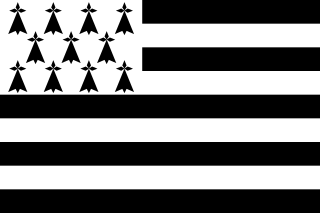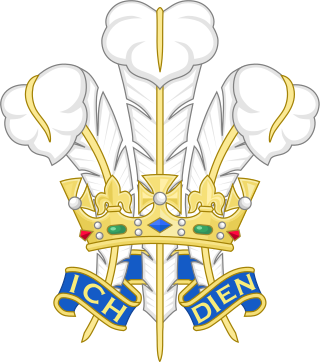
Heraldry is a discipline relating to the design, display and study of armorial bearings, as well as related disciplines, such as vexillology, together with the study of ceremony, rank and pedigree. Armory, the best-known branch of heraldry, concerns the design and transmission of the heraldic achievement. The achievement, or armorial bearings usually includes a coat of arms on a shield, helmet and crest, together with any accompanying devices, such as supporters, badges, heraldic banners and mottoes.

In heraldry, mantling or "lambrequin" is drapery tied to the helmet above the shield. In paper heraldry it is a depiction of the protective cloth covering worn by knights from their helmets to stave off the elements, and, secondarily, to decrease the effects of sword-blows against the helmet in battle, from which it is usually shown tattered or cut to shreds; less often it is shown as an intact drape, principally in those cases where clergy use a helmet and mantling, although this is usually the artist's discretion and done for decorative rather than symbolic reasons.

The royal arms of England is the coat of arms historically used as arms of dominion by the monarchs of the Kingdom of England, and now used to symbolise England generally. The arms were adopted c.1200 by the Plantagenet kings and continued to be used by successive English and British monarchs; they are currently quartered with the arms of Scotland and Ireland in the coat of arms of the United Kingdom. Historically they were also quartered with the arms of France, representing the English claim to the French throne, and Hanover.

Tincture is the limited palette of colours and patterns used in heraldry. The need to define, depict, and correctly blazon the various tinctures is one of the most important aspects of heraldic art and design.

In heraldry, variations of the field are any of a number of ways that a field may be covered with a pattern, rather than a flat tincture or a simple division of the field.

The coat of arms of Australia, officially called the Commonwealth Coat of Arms, is the formal symbol of the Commonwealth of Australia. A shield, depicting symbols of Australia's six states, is held up by native Australian animals, the kangaroo and the emu. The seven-pointed Commonwealth Star surmounting the crest also represents the states and territories, while the national floral emblem appears below the shield.

The flag of the state of Maryland is the 17th-century heraldic banner of arms of Cecil, 2nd Baron Baltimore. It consists of the arms of his father George, 1st Baron Baltimore (1579–1632), quartered with those of his grandmother, heiress of the Crossland family. The flag was officially adopted by the General Assembly of Maryland in 1904.

The flag of Brittany, a region in the northwest of France, is called the Gwenn-ha-du, pronounced [ɡwɛnaˈdyː], which means white and black, in Breton. The flag was designed in 1923 by Morvan Marchal. It is also unofficially used in the department of Loire-Atlantique, although this now belongs to the Pays de la Loire and not to the region of Brittany, as the territory of Loire-Atlantique is historically part of the province of Brittany. Nantes, its prefecture, was once one of the two capital cities of Brittany.

The Prince of Wales's feathers is the dexter heraldic badge of the Prince of Wales. It consists of three white ostrich feathers encircled by a gold coronet. A ribbon below the coronet bears the German motto Ich dien. As well as being used in royal heraldry, the badge is sometimes used to symbolise Wales, particularly in Welsh rugby union and Welsh regiments of the British Army.

Ralph de Gaël was the Earl of East Anglia and Lord of Gaël and Montfort. He was the leading figure in the Revolt of the Earls, the last serious revolt against William the Conqueror.

Ermine in heraldry is a "fur", a type of tincture, consisting of a white background with a pattern of black shapes representing the winter coat of the stoat. The linings of medieval coronation cloaks and some other garments, usually reserved for use by high-ranking peers and royalty, were made by sewing many ermine furs together to produce a luxurious white fur with patterns of hanging black-tipped tails. Due largely to the association of the ermine fur with the linings of coronation cloaks, crowns and peerage caps, the heraldic tincture of ermine was usually reserved to similar applications in heraldry. In heraldry it has become especially associated with the Duchy of Brittany and Breton heraldry.

The Kroaz Du is a flag of Brittany, used as an emblem of the independent duchy in the late Middle Ages. In the Breton language, kroaz means cross and du means black.
This is a list of coats of arms of Ireland. In the majority of cases these are arms assigned to county councils created by the Local Government (Ireland) Act 1898 or later legislation, either by the Chief Herald of Ireland in what is now the Republic of Ireland or by the College of Arms in Northern Ireland. All but two county councils in the Republic have a coat of arms. In Northern Ireland county councils were abolished in 1973, but the traditional arms are still occasionally used.

German heraldry is the tradition and style of heraldic achievements in Germany and the Holy Roman Empire, including national and civic arms, noble and burgher arms, ecclesiastical heraldry, heraldic displays and heraldic descriptions. German heraldic style is one of the four major broad traditions within European heraldry and stands in contrast to Gallo-British, Latin and Eastern heraldry, and strongly influenced the styles and customs of heraldry in the Nordic countries, which developed comparatively late. Together, German and Nordic heraldry are often referred to as German-Nordic heraldry.

The 81st Field Artillery Regiment is a field artillery regiment of the United States Army.

A number of cross symbols were developed for the purpose of the emerging system of heraldry, which appeared in Western Europe in about 1200. This tradition is partly in the use of the Christian cross an emblem from the 11th century, and increasingly during the age of the Crusades. Many cross variants were developed in the classical tradition of heraldry during the late medieval and early modern periods. Heraldic crosses are inherited in modern iconographic traditions and are used in numerous national flags.

The Shropshire flag is the county flag of Shropshire. It was registered with the Flag Institute in March 2012 and officially became the county's flag on 19 April 2013.

The Bedfordshire flag is the flag of the English county of Bedfordshire. It is based on the banner of the arms of the former Bedfordshire County Council, which was granted the arms in 1951 by the College of Arms. This design was adopted as the flag of the historic county in September 2014, with the support of the High Sheriff of the county.
















